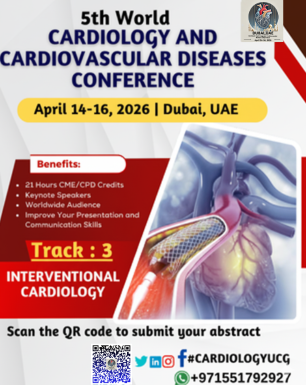Sub-Tracks diabetic-cardiomyopathy:
Pathophysiology of Diabetic Cardiomyopathy, Insulin Resistance and Heart Function, Diabetic Myocardial Dysfunction, Hyperglycemia and Cardiovascular Risk, Diabetic Cardiomyopathy and Inflammation, Role of Advanced Glycation End Products (AGEs), Diabetic Cardiomyopathy and Oxidative Stress, Mitochondrial Dysfunction in Diabetic Cardiomyopathy, Diabetic Heart Failure, Diabetic Cardiomyopathy and Autonomic Dysfunction,
What is diabetic-cardiomyopathy?
diabetic-cardiomyopathy is a type of heart disease that occurs as a result of diabetes. It refers to the heart muscle's impaired ability to function properly due to the long-term effects of uncontrolled blood sugar (hyperglycemia) and the metabolic disturbances associated with diabetes. Unlike heart disease caused by coronary artery disease or hypertension, diabetic cardiomyopathy develops directly from the diabetic condition itself, without the need for atherosclerosis or other external cardiovascular issues.
1. Impaired Heart Function:
- Diabetic cardiomyopathy
leads to a condition where the heart’s ability to pump blood efficiently
is reduced, resulting in symptoms similar to heart failure (e.g., shortness
of breath, fatigue, fluid retention).
- Early Stages:
- In the early stages,
diabetic cardiomyopathy may present with diastolic dysfunction,
where the heart has difficulty relaxing and filling with blood between
beats. This leads to an increase in filling pressures within the heart,
contributing to fluid buildup in the lungs and other parts of the body.
- Late Stages:
- Over time, as the condition
progresses, systolic dysfunction can develop, where the heart
becomes less able to contract and pump blood effectively. This may
eventually lead to heart failure with reduced ejection fraction
(HFrEF).
Pathophysiology of Diabetic Cardiomyopathy:
Several
mechanisms contribute to the development and progression of diabetic
cardiomyopathy, including:
- Hyperglycemia:
- Chronic high blood sugar
leads to the formation of advanced glycation end-products (AGEs),
which damage the heart tissue, leading to fibrosis, inflammation, and
stiffening of the heart muscle.
- Insulin Resistance:
- In diabetes, the body’s
cells become less responsive to insulin, contributing to abnormal
metabolic processes and lipid imbalances that affect the heart. Insulin
resistance leads to increased fat storage in the heart muscle, further
impairing its function.
- Oxidative Stress:
- High blood sugar increases
the production of free radicals, which cause damage to the heart cells
and tissues, leading to inflammation and impaired function.
- Autonomic Dysfunction:
- Diabetic neuropathy can
affect the autonomic nervous system, which controls heart rate and blood
pressure. This dysfunction can contribute to the development of
arrhythmias (irregular heartbeats) and other cardiovascular problems.
- Microvascular Dysfunction:
- Diabetes can cause damage
to the small blood vessels (microvessels) that supply the heart muscle
with oxygen and nutrients. This leads to poor myocardial perfusion,
contributing to ischemia (lack of blood flow) and worsening heart
function.
- Fibrosis:
- Over time, the heart muscle
in diabetics can become stiff due to the buildup of connective tissue
(fibrosis), further impairing the heart's ability to pump blood
effectively.
Risk Factors:
- Uncontrolled Blood Sugar: Long-standing, poorly
controlled diabetes is a primary risk factor.
- Hypertension: High blood pressure often
coexists with diabetes and exacerbates the damage to the heart.
- Obesity: Excess body weight,
particularly abdominal fat, increases the risk of both diabetes and heart
disease.
- Dyslipidemia: Abnormal levels of
cholesterol and triglycerides often seen in diabetes can lead to
atherosclerosis, further complicating the cardiovascular condition.
- Age: Older individuals with
diabetes are more likely to develop diabetic cardiomyopathy.
Symptoms:
- Shortness of breath,
especially with exertion.
- Fatigue and weakness.
- Swelling in the legs,
ankles, or abdomen (due to fluid buildup).
- Reduced ability to exercise
or perform daily activities.
- Heart palpitations or
irregular heartbeats.
Diagnosis:
- Clinical Evaluation:
- Assessment of symptoms,
medical history, and risk factors (e.g., diabetes, hypertension).
- Echocardiography:
- Used to evaluate heart
function, detect diastolic dysfunction, and assess for signs of heart
failure.
- Cardiac MRI:
- Provides detailed images of
the heart’s structure and function, helping to detect fibrosis and other
abnormalities.
- Blood Tests:
- To assess blood sugar
control, lipid levels, and markers of heart failure (e.g., B-type
natriuretic peptide, or BNP).
- Electrocardiogram (ECG):
- To assess for arrhythmias,
which are common in diabetic cardiomyopathy.
Treatment:
The
treatment of diabetic cardiomyopathy focuses on managing diabetes, improving
heart function, and preventing complications:
- Glycemic Control:
- Tight control of blood
sugar through medication (e.g., insulin, oral hypoglycemics) and
lifestyle changes is crucial.
- Blood Pressure Management:
- Controlling high blood
pressure using ACE inhibitors, angiotensin receptor blockers (ARBs),
beta-blockers, or calcium channel blockers.
- Heart Failure Medications:
- Medications such as ACE
inhibitors, beta-blockers, and diuretics may be used to manage symptoms
of heart failure and improve heart function.
- Statins:
- Statins may be prescribed
to lower cholesterol levels and reduce the risk of cardiovascular events.
- Lifestyle Modifications:
- Dietary changes, regular
physical activity, and weight management are key components in managing
both diabetes and heart health.
- Cardiac Devices:
- In severe cases, devices
like implantable cardioverter-defibrillators (ICDs) or pacemakers
may be needed to manage arrhythmias or heart failure.
Prognosis:
- The prognosis for diabetic
cardiomyopathy varies, but it is generally poorer than for other types of
heart failure, especially if diabetes is poorly controlled. Early
detection and management of both diabetes and heart function can
significantly improve outcomes and quality of life.





